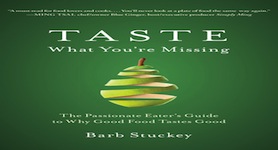By: Justin Chao
Taste What You’re Missing by Barb Stuckey was a great introduction to the basics of taste physiology. In her book, Barb Stuckey gives a good introduction to how each of our five senses contributes to the way we taste our food. Even sound will affect the way that we perceive the flavor of food. For example, when people were given potato chips and were played loud sounds of potato chips being eaten, they rated the potato chips crisper than people who were played quieter sounds of chips being eaten. She also discussed each of the five taste sensations: sweet, sour, bitter, salty and umami. Umami is the taste sensation that detects savory or meaty flavors. Umami has only recently been widely accepted as a taste sensation. In fact, it was only proven in 2000 that tastebuds exist in the mouth for umami. I found this chapter especially interesting since I really had no concept of what pure umami flavor tasted like.
In her book, Barb Stuckey is able to make complex concepts easy to understand through her accessible writing style. In addition, she includes experiments at the end of each chapter so that the reader can experience some of the concepts that she discusses. I decided to do the experiment at the end of the umami chapter. This experiment called for an umami enhancer, monosodium glutamate (MSG), and table salt. I also decided to try the experiment with a product that contained not only monosodium glutamate (MSG) but also guanosine monophosphate (GMP) and inosine monophosphate (INP). GMP and INP have also proven to be umami enhancers.
The experiment calls for 3 bowls of water with 2/3 cup of warm water added to it. I then added 1/8 of a teaspoon of salt to the first bowl, ¾ teaspoon of MSG to the second bowl, and ¾ teaspoon of MSG + INP + GMP to the third bowl. I then tasted each of the solutions.

The following are the results of the experiment:
1> Salt Solution
It tasted neutral to me. I didn’t want to drink more of it.
2> MSG Solution
Tastes salty but I wanted to drink more of it. It tasted savory like chicken broth or stock. It had a comforting flavor.
3> MSG + INP + GMP Solution
Tasted salty but compared to just the straight MSG it had a more complex aftertaste that made it an even fuller flavor than the just the straight MSG. THE MSG solution tastes flat after tasting the MSG + INP + GMP solution.
Have you performed any science-related experiments at home? Tell us more in the comments below!
Taste Photo Credit: http://blog.wblakegray.com/2012/07/taste-what-youre-missing-taste-science.html






Hi Justin, thanks for sharing. Looks like a really interesting read! I took a biochemistry class online last semester and for the lab portion they send out a kit with chemicals and instructions. It was pretty cool, there were several food-related experiments such as measuring the concentration of blue dye in different types of drinks, burning food products to calculate the calories, measuring the sugar content of various drinks and also measuring pH of various liquids using home-made pH testing strips.
That sounds cool Thomas. I just finished taking a flavor seminar at the IFT conference, and we did some of the same exact experiments that were in the book. It’s a great resource if you have the time to learn more about how each of our senses contributes to how we perceive flavor in what we eat.